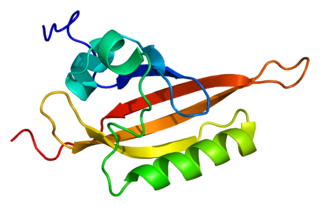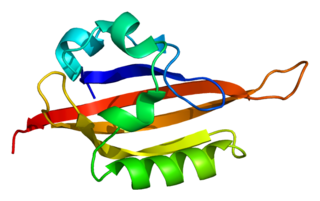Related Research Articles

A basic helix-loop-helix (bHLH) is a protein structural motif that characterizes one of the largest families of dimerizing transcription factors.

The aryl hydrocarbon receptor is a protein that in humans is encoded by the AHR gene. The aryl hydrocarbon receptor is a transcription factor that regulates gene expression. It was originally thought to function primarily as a sensor of xenobiotic chemicals and also as the regulator of enzymes such as cytochrome P450s that metabolize these chemicals. The most notable of these xenobiotic chemicals are aromatic (aryl) hydrocarbons from which the receptor derives its name.

The ARNT gene encodes the aryl hydrocarbon receptor nuclear translocator protein that forms a complex with ligand-bound aryl hydrocarbon receptor (AhR), and is required for receptor function. The encoded protein has also been identified as the beta subunit of a heterodimeric transcription factor, hypoxia-inducible factor 1 (HIF1). A t(1;12)(q21;p13) translocation, which results in a TEL-ARNT fusion protein, is associated with acute myeloblastic leukemia. Three alternatively spliced variants encoding different isoforms have been described for this gene.

NPAS3 or Neuronal PAS domain protein 3 is a brain-enriched transcription factor belonging to the bHLH-PAS superfamily of transcription factors, the members of which carry out diverse functions, including circadian oscillations, neurogenesis, toxin metabolism, hypoxia, and tracheal development. NPAS3 contains basic helix-loop-helix structural motif and PAS domain, like the other proteins in the superfamily.

Hypoxia-inducible factor 1-alpha, also known as HIF-1-alpha, is a subunit of a heterodimeric transcription factor hypoxia-inducible factor 1 (HIF-1) that is encoded by the HIF1A gene. It is a basic helix-loop-helix PAS domain containing protein, and is considered as the master transcriptional regulator of cellular and developmental response to hypoxia. The dysregulation and overexpression of HIF1A by either hypoxia or genetic alternations have been heavily implicated in cancer biology, as well as a number of other pathophysiologies, specifically in areas of vascularization and angiogenesis, energy metabolism, cell survival, and tumor invasion. Two other alternative transcripts encoding different isoforms have been identified.

Neuronal PAS domain protein 2 (NPAS2) also known as member of PAS protein 4 (MOP4) is a transcription factor protein that in humans is encoded by the NPAS2 gene. NPAS2 is paralogous to CLOCK, and both are key proteins involved in the maintenance of circadian rhythms in mammals. In the brain, NPAS2 functions as a generator and maintainer of mammalian circadian rhythms. More specifically, NPAS2 is an activator of transcription and translation of core clock and clock-controlled genes through its role in a negative feedback loop in the suprachiasmatic nucleus (SCN), the brain region responsible for the control of circadian rhythms.

Transcription factor 3, also known as TCF3, is a protein that in humans is encoded by the TCF3 gene. TCF3 has been shown to directly enhance Hes1 expression.

DNA-binding protein inhibitor ID-2 is a protein that in humans is encoded by the ID2 gene.

Neurogenic differentiation 1 (NeuroD1), also called β2, is a transcription factor of the NeuroD-type. It is encoded by the human gene NEUROD1.

Endothelial PAS domain-containing protein 1 is a protein that is encoded by the EPAS1 gene in humans. It is a type of hypoxia-inducible factor, a group of transcription factors involved in the physiological response to oxygen concentration. The gene is active under hypoxic conditions. It is also important in the development of the heart, and for maintaining the catecholamine balance required for protection of the heart. Mutation often leads to neuroendocrine tumors.

DNA-binding protein inhibitor ID-1 is a protein that in humans is encoded by the ID1 gene.

DNA-binding protein inhibitor ID-3 is a protein that in humans is encoded by the ID3 gene.

Upstream stimulatory factor 2 is a protein that in humans is encoded by the USF2 gene.

Transcription factor 12 is a protein that in humans is encoded by the TCF12 gene.

Hairy/enhancer-of-split related with YRPW motif protein 1 is a protein that in humans is encoded by the HEY1 gene.

Class E basic helix-loop-helix protein 40 is a protein that in humans is encoded by the BHLHE40 gene.

Single-minded homolog 1 also known as class E basic helix-loop-helix protein 14 (bHLHe14) is a protein that in humans is encoded by the SIM1 gene.

Aryl hydrocarbon receptor nuclear translocator-like protein 1 (ARNTL) or Brain and Muscle ARNT-Like 1 (BMAL1) is a protein that in humans is encoded by the Bmal1 gene, also known as ARNTL, MOP3, and, less commonly, BHLHE5, BMAL, BMAL1C, JAP3, PASD3, and TIC.

A Per-Arnt-Sim (PAS) domain is a protein domain found in all kingdoms of life. Generally, the PAS domain acts as a molecular sensor, whereby small molecules and other proteins associate via binding of the PAS domain. Due to this sensing capability, the PAS domain has been shown as the key structural motif involved in protein-protein interactions of the circadian clock, and it is also a common motif found in signaling proteins, where it functions as a signaling sensor.

Neuronal PAS domain protein 4 is a protein that in humans is encoded by the NPAS4 gene. The NPAS4 gene is a neuronal activity-dependent immediate early gene that has been identified as a transcription factor. The protein regulates the transcription of genes that control inhibitory synapse development, synaptic plasticity and most recently reported also behavior.
References
- ↑ Zhou YD, Barnard M, Tian H, Li X, Ring HZ, Francke U, Shelton J, Richardson J, Russell DW, McKnight SL (January 1997). "Molecular characterization of two mammalian bHLH-PAS domain proteins selectively expressed in the central nervous system". Proc. Natl. Acad. Sci. U.S.A. 94 (2): 713–8. doi:10.1073/pnas.94.2.713. PMC 19579 . PMID 9012850.
- ↑ Hogenesch JB, Chan WK, Jackiw VH, Brown RC, Gu YZ, Pray-Grant M, Perdew GH, Bradfield CA (March 1997). "Characterization of a subset of the basic helix-loop-helix-PAS superfamily that interacts with components of the dioxin signaling pathway". J. Biol. Chem. 272 (13): 8581–93. doi: 10.1074/jbc.272.13.8581 . PMID 9079689.